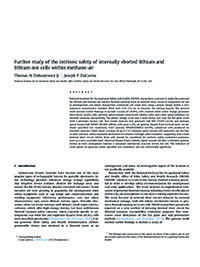Mining Publication: Further Study of the Intrinsic Safety of Internally Shorted Lithium and Lithium-ion Cells Within Methane-air
Original creation date: November 2014
National Institute for Occupational Safety and Health (NIOSH) researchers continue to study the potential for lithium and lithium-ion battery thermal runaway from an internal short circuit in equipment for use in underground coal mines. Researchers conducted cell crush tests using a plastic wedge within a 20-L explosion-containment chamber filled with 6.5% CH4-air to simulate the mining hazard. The present work extends earlier findings to include a study of LiFePO4 cells crushed while under charge, prismatic form factor LiCoO2 cells, primary spiral-wound constructed LiMnO2 cells, and crush speed influence on thermal runaway susceptibility. The plastic wedge crush was a more severe test than the flat plate crush with a prismatic format cell. Test results indicate that prismatic Saft MP 174565 LiCoO2 and primary spiral-wound Saft FRIWO M52EX LiMnO2 cells pose a CH4-air ignition hazard from internal short circuit. Under specified test conditions, A123 systems ANR26650M1A LiFePO4 cylindrical cells produced no chamber ignitions while under a charge of up to 5 A. Common spiral-wound cell separators are too thin to meet intrinsic safety standards provisions for distance through solid insulation, suggesting that a hard internal short circuit within these cells should be considered for intrinsic safety evaluation purposes, even as a non-countable fault. Observed flames from a LiMnO2 spiral-wound cell after a chamber ignition within an inert atmosphere indicate a sustained exothermic reaction within the cell. The influence of crush speed on ignitions under specified test conditions was not statistically significant.
Authors: TH Dubaniewicz, JP Ducarme
Peer Reviewed Journal Article - November 2014
NIOSHTIC2 Number: 20045308
J Loss Prev Process Ind 2014 Nov; 32:165-173
See Also
- Are lithium-ion cells intrinsically safe?
- Battery Safety Enhancements for Underground Coal Mines
- The Brookwood Disaster and Electrical Requirements for Hazardous (Classified) Locations
- Ignition of Hydraulic Fluid Sprays by Open Flames and Hot Surfaces
- Ignition Tests With a Fiber-Optic Powered Instrument
- Lasers
- Methane-Air Mixtures Ignited by CW Laser-Heated Targets on Optical Fiber Tips: Comparison of Targets, Optical Fibers, and Ignition Delays
- Threshold Powers and Delays for Igniting Propane and Butane-Air Mixtures by CW Laser-heated Small Particles
- U.S. Bureau of Mines/NIOSH Mining Electrical Safety Research: A Legacy of Protection Against Shock, Fires, and Explosions
- Using Advanced Large-Format Energy Storage Technology in Underground Mines
- Content source: National Institute for Occupational Safety and Health, Mining Program


 ShareCompartir
ShareCompartir
